SS Princess Sophia: Oil Soaked Dog Was the Only Survivor
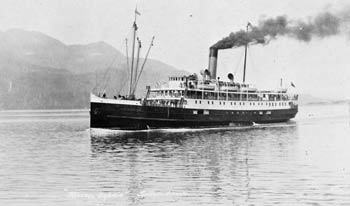
The SS Princess Sophia was one of four “Princess” liners to sail the Alaska/Canada Inside Passage. Credit: Library of Congress
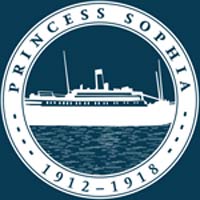
Logo of the SS Princess Sophia owned and operated by the Canadian Pacific Railroad. Credit: Alaska Dept. of Tourism
Princess Sophia was three hours off schedule leaving Skagway just before snow started to fall. Winds picked up and fog engulfed the ship as Capt. Leonard Locke maneuvered his ship through the labyrinth of islands, islets and fiords. Despite the harsh conditions, Capt. Locke, 25 years a master maritime pilot, opted to push his vessel through the maze of islands at eleven knots instead of the usual four. Perhaps he was trying to make up for the late departure. Regardless, this was still a fast pace in threatening weather conditions. As visibility dropped to nearly zero, the ship went a mile and a half off course and slammed into Vanderbilt Reef.
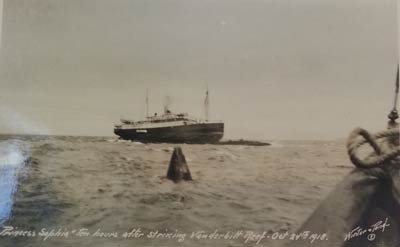
The Princess Sophia went up on the reef and looked liked a cherry on top of an ice cream sundae. Credit: Library of Congress
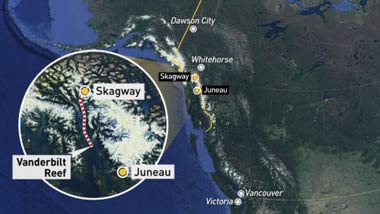
Map sows where SS Princess Sophia sank. Credit: Alaska Dept. of Tourism
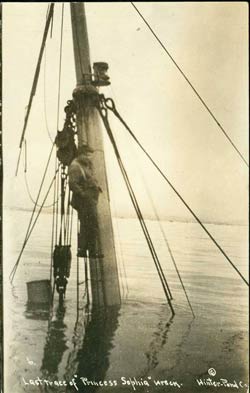
A man, who was lost later, clings to the mast of the sunken ship. Credit: Library of Congress
Experienced divers visit the wreck site which offers good visibility—25 to 50 feet—accompanied by strong currents. The ship broke in two as it slid off the reef into waters 80 to 100 feet deep—and has been hammered by storms and heavy seas for over 100 years. Boilers remain in the sand surrounded by a maze of steel plating and beams all covered by white sea anemones. Sea lions frequent the wreck to feed on fish that hide in the shadows of the rubble. Google offers “Videos of the SS Princess Sophia” for armchair divers who want to see the remains of a proud ship that tendered a dog as its only survivor.
Author: Ellsworth Boyd
Ellsworth Boyd, Professor Emeritus, College of Education, Towson University, Towson, Maryland, pursues an avocation of diving and writing. He has published articles and photo’s in every major dive magazine in the US., Canada, and half a dozen foreign countries. An authority on shipwrecks, Ellsworth has received thousands of letters and e-mails from divers throughout the world who responded to his Wreck Facts column in Sport Diver Magazine. When he’s not writing, or diving, Ellsworth appears as a featured speaker at maritime symposiums in Los Angeles, Houston, Chicago, Ft. Lauderdale, New York and Philadelphia. “Romance & Mystery: Sunken Treasures of the Lost Galleons,” is one of his most popular talks. A pioneer in the sport, Ellsworth was inducted into the International Legends of Diving in 2013.
13 Comments
Submit a Comment
All Rights Reserved © | National Underwater and Marine Agency
All Rights Reserved © | National Underwater and Marine Agency
Web Design by Floyd Dog Design
Web Design by Floyd Dog Design

I have been trying to find more about the lone survivor – this article reports it as an Irish setter, there was a report on the sinking in the Alaska Triangle which reports it as an English Setter. The dogs name and history would be nice to know along with a verification of which breed it actually is.
It could have been an English Setter. Both Irish and English Setters were reported in the newspapers. See if you can find micro film of back issues of other newspapers. And contact the curators of any museums and see if they have any records…again, possibly microfilm of newspapers. Search online and see if there has been a book written about the disaster. Also see if you can track down manifests of the ships of the Princess Lines. You might stumble upon the manifest of the Princess Sophia. Let me know how you do.
What happened to the survival dog???
That’s a good question. I’m sure you could find some details by going back through the microfilm from newspapers of that time period. I would imagine that the SPCA or some good Samaritan took the dog in.
ONLY SURVIVOR OF SOPHIA Reprinted in the Weekly STAR Mar. 21, 1919.
An English setter, the only survivor of the Princess Sophia, is making himself at home in Auk Bay, having arrived there from Tee Harbor and attached itself to the cannery settlement there, according to word brought to Juneau by L. E. Lloyd, superintendent of the John L. Carlson & Company cannery.
According to those who know the story, the dog arrived at Tee Harbor covered with oil, half wild and almost starved, shortly after the Princess foundered. It possessed a fear of salt water that it has not overcome. It is supposed that the dog reached shore from the wreck and found its way to the nearest settlement.
When told about the dog, L.H. Johnston, agent of the Canadian Pacific at Skagway, said that he remembered that several dogs were checked on the Sophia. He said that when he returned to Skagway he would inquire whether or not any of the dogs that left Skagway would answer to the description of the little wild thing which sought refuge at Tee Harbor so soon after the accident occurred.
It was later determined that the dog probably belonged to Captain James Alexander and his wife Louise, owners of the Engineer Mine on the southern shore of Tagish Lake. They both perished in the wreck.
Understand it lived out its days in North Vancouver, B.C. but I do not know with what family.
There were several from N.Van on the ship including the Third (second ?) Mate Arthur Murphy.
Steve: Drop down just a little bit in Comments and read what Tony sent. It is well done and has a lot of good research on what happened to the “lone survivor.”
About the dog, it appears from these sources that a) it was not either an English Setter or Irish Setter as mentioned, but rather a Chesapeake Bay Retriever. These have water shedding coats and webbed feet, which would help explain why it alone survived. Also the long snout would help keep oil away from the lungs, which was a primary cause of death. Only a few passengers drowned, whereas hypothermia and oil inhalation was the main cause.
https://www.thescubanews.com/2020/10/22/unsolved-mystery-of-the-sinking-of-the-ss-princess-sophia/
“The original letter had been forwarded to a gentleman by the name of Reginald Brock c/o the Engineer Mine in Atlin, BC on July 8th, 1919 by the Official Administrator of the Estate of the late James Alexander,” For all these years the dog was reported to be an English Setter while according to the recently discovered letter, the dog was identified as a Chesapeake Bay Retriever named “Tommy.”
The discovery of this letter over 100 years later reopens the mystery of what happened to the one lone dog that survived the tragic sinking of the SS Princess Sophia and may help to explain why the dog was able to survive the frigid waters of the Lynn Canal in late October.
https://evelazarus.com/the-sinking-of-the-princess-sophia/
Also, at least one passenger seems to have made it to shore, as his cause of death was a massive bashing of the head, found on the rocky beach. In the storm, he may well have simply been mauled by the heavy surf or by climbing up the rocks. He expired soon afterwards.
I forgot the source for that one, but it is online.
One mistake the the Captain, who apparently had quite a bad local reputation and seems to have wanted to keep his cards close to his chest as to avoid sailor talk after the ‘rescue’: why not just ADD weight to the rear of the ship (windward, with great wave ‘fetch’ along canal), namely water pumped up into either barrels or water tight bulkheads. This would have limited if not prevented the scouring of the rocks and lifting to resettle at great depths, about 100 feet below.
Instead he gambled that the wind would not almost perfectly align with long canal, making the almost always protected passage not at all protected with a nearly 100 mile long gathering of wave height ‘fetch’. The temporarily rising of barometer means little, as sometimes happens with the most vicious tail of a storm. The Edmund Fitzgerald sinking was similar in this respect as recalled, along with holding the condition close to the chest by the respective captains like a poker hand.
It would not have taken much as the tides on the reef are only about 20 feet maximum above reef level at spring/storm surge. Even the nearly indestructible huge tabular Antarctic icebergs have been written up in a scholarly paper of how most meet their end by lowly 2 foot waves coming from far away Gulf of Alaska (during their summer, when the protective sea ice sheet is missing). All other sources come at too much an angle and do not penetrate, whereas the bergs are held next to the coast by the Coriolis Effect.
The rising and falling of the ice causes cracks, which break them into bits during this two to six week window. By the time they meet up with the Antarctic Peninsula, these are broken into smaller chunks 24/7, and these melt in the warmer water of the circumpolar current. The other water is about -3 C, thus the fresh water of the ice does not melt and often heals fracture lines. The Gulf of Alaska waves are up to about 60 feet tall, but lose energy to the 2 foot size nearly half a world away, by the way.
Hind sight is almost always much better than real time events in a crisis. For example it is a rare commander that even does a C level work in wartime, as Napoleon called them ‘geniuses’, while the A levels panic and do F or D style to great damage for their forces. Same goes for damage control on a ship. However, the captain here had days to think it over, and it never dawned upon him to move out some areas to flood, rearrange cargoes, and force passengers into upper staterooms towards the bow.
An 1883 Krakatoa captain saved his ship by forcing all passengers to assemble in the bilge holds, including the white first class ones to intense threats. He saved his ship from the 100 foot or so tsunami by doing so. Damage control in nearly unique circumstances is an art, not a science, and each time the mechanics are somewhat different. Think of Theodore Roosevelt’s Man in the Arena.
Thanks for the additional information which is quite interesting. I like what you described in identifying the dog as a Chesapeake Bay retriever. I had a “Chessie” for twelve and a half years and he was just like you described. At the beach in Ocean City, Maryland, he actually swam through breaking waves to retrieve a stick I had thrown beyond the waves. He wouldn’t return without it. Thanks for the rest of the information you sent.
Thank you to all, very informative.
Thank you as well. If any more info comes up, I shall post it. Best regards, E.B.
Were there also horses on board
That’s a good question. Yes, there were. It was common in those days for rich horse owners to ship their favorite ones to tracks or auctions. Those aboard the Princess Sophia were lost at sea.